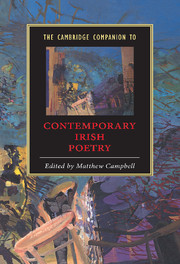Book contents
- Frontmatter
- 1 Ireland in poetry
- 2 From Irish mode to modernisation
- 3 Patrick Kavanagh and antipastoral
- 4 Louis MacNeice
- 5 The Irish modernists and their legacy
- 6 Poetry of the 1960s
- 7 Violence in Seamus Heaney's poetry
- 8 Mahon and Longley
- 9 Between two languages
- 10 Boland, McGuckian, Ni Chuilleanain and the body of the nation
- 11 Sonnets, centos and long lines
- 12 Performance and dissent
- 13 Irish poets and the world
- 14 Irish poetry into the twenty-first century
- Further reading
- Index
- Series List
3 - Patrick Kavanagh and antipastoral
Published online by Cambridge University Press: 28 May 2006
- Frontmatter
- 1 Ireland in poetry
- 2 From Irish mode to modernisation
- 3 Patrick Kavanagh and antipastoral
- 4 Louis MacNeice
- 5 The Irish modernists and their legacy
- 6 Poetry of the 1960s
- 7 Violence in Seamus Heaney's poetry
- 8 Mahon and Longley
- 9 Between two languages
- 10 Boland, McGuckian, Ni Chuilleanain and the body of the nation
- 11 Sonnets, centos and long lines
- 12 Performance and dissent
- 13 Irish poets and the world
- 14 Irish poetry into the twenty-first century
- Further reading
- Index
- Series List
Summary
Iʾm the only man who has written in our time about rural Ireland from the inside.
(Patrick Kavanagh, 1949)ʿPastoralʾ has been defined in a variety of ways, and has been said to include the ʿantipastoralʾ, though some readers will wish to make a rigid distinction between the two, while recognising that both are intimately related. Traditionally, pastoral is a matter of rural life and shepherds, idyllic landscapes in which people corrupted by court and city life are changed and renewed. It suggests a healing antithesis to the corrupting influence of urban experience, but has been characterised simply as poetry of the countryside (however defined), and does not always envision an idealised and falsified, conflict-free zone, transcending the tensions of history, though it can do that, too. ʿAntipastoralʾ, on the other hand, suggests a poetics of undermining, in which pastoral conventions are deployed or alluded to, in order to suggest or declare the limitations of those conventions, or their downright falsity. If pastoral suggests that rural life offers freedom, antipastoral may proclaim it is a prison-house, and the farmers slaves. Historically, antipastoral has been associated with Goldsmithʾs The Deserted Village (1770) and George Crabbeʾs The Village (1783), with certain poems of John Clare, and with Stephen Duck who, in The Thresherʾs Labour (1736) wrote, ʿNo fountains murmur here, no Lambkins play, / No Linnets warble, and no Fields look gayʾ. A defining feature of such poetry has been its realistic treatment of labour, protest against idealising poetic traditions, and in some cases outcry against political conditions related to land enclosure.
- Type
- Chapter
- Information
- The Cambridge Companion to Contemporary Irish Poetry , pp. 42 - 58Publisher: Cambridge University PressPrint publication year: 2003



